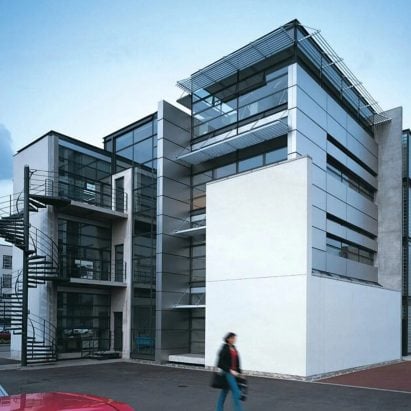Winner of first-ever Stirling Prize to be demolished
Salford City Council has approved the demolition of the University of Salford's Centenary Building, which won the inaugural RIBA Stirling Prize in 1996, despite Twentieth Century Society objection.Completed by British studio Hodder+Partners in 1995, the university building will be razed as part of a major redevelopment project named Adelphi Village.Salford City Council's go-ahead comes despite efforts by campaigners and conservation group Twentieth Century Society to get the building listed, after the threat of demolition was announced in November last year. Historic England denied heritage listing in December 2024.The Centenary Building is set to be demolished. Photo by Morley von Sternberg courtesy of the Twentieth Century Society"The Twentieth Century Society is disappointed and thinks this is the wrong decision," Twentieth Century Society director Catherine Croft told Dezeen."As well as failing to recognise heritage value, the decision not to list has effectively stymied prospects of environmentally sustainable reuse of a substantial and soundly constructed building."TheRoyal Institute of British Architects (RIBA) awarded the Centenary Building the first-ever Stirling Prize in 1996, with judges praising it as a "dynamic, modern and sophisticated exercise in steel, glass and concrete".Originally designed for the University of Salford's School of Electrical Engineering department, the building was used by the Faculty of Art and Design Technology upon its completion. It has stood vacant for over eight years.Read: Cylindrical Bertrand Goldberg building at risk of demolition in IllinoisHistoric England rejected the request for the Centenary Building to be added to the National Heritage List for England in December last year.It claimed in its report that the building did not have the special interest required for listing status and that user complaints of noisy vents and poor temperature control contributed to the decision."Although certainly possessing some claims to interest, when considered against the high standard required for buildings of its age, the Centenary Building lacks the special interest in a national context required to merit listing," Historic England said in the report.The building won the inaugural Stirling Prize"Criticism of the building's functionality, even for its rather narrow original purpose, mitigates against it being considered of sufficiently good quality to merit listing for a building only just over 30 years old," it added."Although undoubtedly of some design interest, the Centenary Building was not technically innovative and has not been shown to be influential elsewhere, as was hoped when it was awarded the Stirling Prize."Croft argued the building has significant interest because of its Stirling Prize win."As the first-ever recipient of the Stirling Prize, the Centenary Building certainly has historic interest," she said."We are concerned that the report relies in part on 30-year-old hearsay, including comments about how well the services originally functioned," she continued. "This is frustrating, as is the somewhat cursory nature of the report."The proposed date for demolition to commence is 1 March 2025.Last year,the Twentieth Century Society selected 10 UK buildings turning 30that it believes should be granted listed status, including Grimshaw Architects' Waterloo International Terminal in London. The group also recently launcheda campaign to preserve a set of cooling towers following the closure of the UK's last coal-fired power station.The photography is by Hodder and Partners courtesy of the Twentieth Century Society unless otherwise stated.The post Winner of first-ever Stirling Prize to be demolished appeared first on Dezeen.


